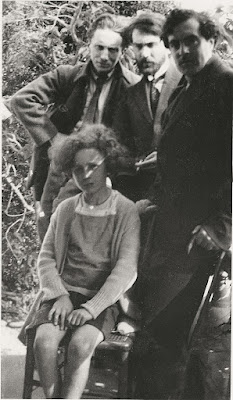Notes on the films of Sam Peckinpah
Last evening I watched Pat Garret and Billy the Kid by Sam Peckinpah. I haven't seen such a film for a very long time, dull melancholic edge tainted with sadness and elegiac to the core. I noticed that there were many production problems, as many as 6 editors, and Peckinpah disowned the film eventually. I think the problem with the film, however, is Bob Dylan, not the editing. He clearly can't act, his presence is irritating and, apart from the well-known song, hardly quoted in the film, the soundtrack is underwhelming. There were so many laudable cameos otherwise, Slim Pickens, Jason Robards, Harry Dean Stanton, and Kris Kristoffersen who pulls it off somehow as Billy but who knows what his acting is really like. I really wished someone would shoot Dylan just to get him out of the film, instead Pickens is shot and various other worthwhile character actors. The still centre of the film is James Coburn in this, his second film for Peckinpah. After he shoots Billy dead he cries 'there is a difference between what you want and what you get' which sums up the mood and themes of the film. The way things work out when everyone started out with high ideals and great hopes.
Today I watched The
Ballad of Cable Hogue by Sam Peckinpah, a total contrast to Pat Garret
and Billy the Kid. It would've been
interesting to see James Coburn play Cable, but I think it would've been a
different picture. Jason Robards is the
right man to play Cable Hogue, a gentle soul who emerges from the desert of New
Mexico like Job or Abraham or Moses and ends up discovering water. The colours of the landscape are the best
thing about the film because I first saw them in the paintings of Georgia
O'Keefe. There are burnt reds, yellows
and the desiccated bluffs and dunes burn their way into the mind. The animals of the prairie appear too, a
coyote, a Gila monster and some rattle snakes that save Cable's bacon in the
end. The tragic outlines of Pat
Garret and Billy the Kid are nowhere to be seen in this film. Another character emerges out of the desert,
David Warner as Joshua, who manages to turn his collar and becomes a reverend
then somehow reverts to being a philanderer again. He is Cable Hogue's one true friend in a
world of enmity, hate and murder.
The film is all about the
end of the west and the coming of cars, motorways, diners and even movie
houses. There are shades of The Wild
Bunch. In that film the townfolk's children destroy a nest of scorpions, a motiveless act of slaughter implying the new morality of the west, nihilistic and deprived of meaning. The coming of the machine gun presages impending doom (the film
is set in 1913) but really the chivalric code of the old West is dying and
that's what's really at stake in these films.
That's the sadness that the character's endure. The Ballad of Cable Hogue is much more
coherent and intelligible than Pat Garret and Billy the Kid which seems
confused and sounds inarticulate but still strikes me as being a major film. However, The Wild Bunch is without doubt Peckinpah's masterpiece. The characters, Pike Bishop, Dutch Engstrom and Deke Thornton, are all hard-bitten, men of the world, who relinquish their world weariness to reclaim the code of honour that is their catechism. The film's climactic shootout, perhaps the most gripping Mexican standoff in all of cinema, begins with the bunch's determination to rescue their friend Angel from the clutches of General Mapache, an officer in the Mexican Federal Army.
Peckinpah's last major film was undoubtedly Cross of Iron (1977). The film was set on an obscure sector of the eastern front in Crimea towards the end of WW2 and shot from the German perspective. James Coburn delivers his best performance in a Peckinpah film as Sergeant Rolf Steiner and the conflict between him and Hauptmann Stransky who seeks an Iron Cross, the highest medal of bravery in the German army, is the core of the film. The supporting cast of Oberst Brandt (James Mason), Hauptmann Kiesel (David Warner) confer a sense of authenticity upon the film which I also found in Ernst Juenger's novel Storm of Steel, his account of WW1. In that novel Juenger is brought before the General expecting to be arrested only for the General to stick an Iron Cross on his lapel, a sticking plaster for his many wounds.
The film's theme is the German class system. Stransky represents the Prussian aristocratic Junker class, devoid of any moral fibre whatsoever, seeking attention and glory. Steiner is perhaps closer to the hard-bitten soldier of the eastern front, a man disinterested in ideology seeking a way through to the other side of the war. Although it is inevitably trite, Cross of Iron aims its darts at the right places. Implying that German history is somehow a continuum from Immanuel Kant (the son of a saddle maker) to Franz Schubert (the son of a school teacher) to the Fuehrer himself (the son of a minor customs official) all German history bears down upon the Stranskys who have done absolutely nothing to earn the privileges they enjoy. It is the class that Stransky represents that have betrayed the war effort and it is for them that the war is being fought, the aftermath will be their re-settlement of vast estates and their retirement to private life whereas the Steiner's of this world probably inherit a small plot of land in an unknown nowhere, kicking up daisys as it were. There are some women in the film too like Senta Berger as Eva, the nurse who looks after Steiner when he is wounded and a platoon of Russian women soldiers who fall foul of Steiner's platoon in scenes that are rather misogynistic and unpleasant yet probably truthful.

Comments